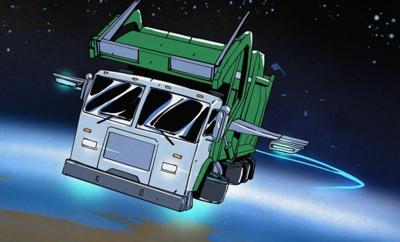Orbital Hygiene
The US Federal Aviation Administration has proposed a new set of regulations by which to mitigate the occurrence and proliferation of so-called space-junk left in the wakes of commercial space-launches undertaken by concerns the likes of SpaceX, Blue Origin, and Rocket Lab.

The agency has drafted a Notice of Proposed Rule-Making (NPRM) requiring operators of commercial space-launches to assume responsibility for disposing of the upper-stages of spent launch-vehicles.
Magnanimous in perpetuity, the FAA has set forth five means by which Elon, Jeff, and company might comply with its proposed dictate. The proffered options include: the conducting of controlled re-entries; uncontrolled atmospheric disposal (likely a euphemism for burn up or blow up during re-entry); maneuvering spent upper-stages to a designated storage or graveyard orbit; retrieving spent upper-stages within five-years; and propelling spent stages free of Earth’s gravity and into open space.
That the latter option bears an uncanny and unattractive ideological similarity to dumping one’s trash on the neighbor’s lawn is undeniable.
The FAA proposed, also, that operators of commercial space launches should be allowed up to 25-years to remove spent upper-stages from orbit by dint of the aforementioned “uncontrolled method.”
The FAA ascribes the issuance of its space-junk NPRM to the ever-increasing numbers of satellites, fragmented material, non-functional spacecraft, rocket bodies, and mission-related items stuck in orbit around Mother Earth. By way of example, the agency cited the large numbers of satellites launched in recent years by broadband providers such as OneWeb (684 satellites) and Starlink (4,500 satellites). Not to be outdone, Amazon, too, intends to cash in on the lucrative broadband connectivity market. Bezos’s boffins, by way of the company’s nascent Kuiper Systems project, propose to pack another 3,236 satellites into the already-crowded Low Earth Orbit (LEO) sphere.

According to the FAA, the number of extant orbital objects measuring ten-centimeters or greater in size is estimated to be over 23,000. The agency further posits orbital objects measuring between one-and-ten centimeters currently number approximately 500,000, while objects larger than one-millimeter now number in excess of one-hundred-million.
The agency maintains collisions between large orbital objects—such as spent launch-vehicle stages—contribute most significantly to the genesis of space-junk.
Under the FAA’s newly-proposed NPRM, space-launch operators would remain obligated to submit Orbital Debris Assessment Plans (ODAPs) prior to all launches. Moreover, launch-providers would be required, henceforth, to remove any debris fragments measuring greater than five-millimeters from highly-used orbits within 25-years.
Of the five disposal options presented by the FAA, launch concerns may choose to dispose of debris resultant of their operations within thirty-days of mission-completion via controlled disposal—which is to say maneuvering debris to a disposal orbit or propelling spent stages, components, etc. beyond Earth orbit.
Alternatively, operators may either retrieve orbital debris within five-years of mission-completion or—should the debris in question meet established risk criteria—allow for uncontrolled atmospheric disposal or natural decay thereof within 25-years. The FAA concedes, however, that within the context of orbital operations conducted below altitudes of six-hundred-kilometers, smaller pieces of debris may reasonably be expected to burn up upon re-entry into Earth’s atmosphere within the allowable time-limitation.

The FAA claims the newly-proposed set of regulations will not adversely impact U.S. companies’ ability to compete successfully in the international space-launch market. The agency asserts foreign space-launch operators are constrained to operate under similar—in some instances more restrictive—guidelines established and enforced by the Inter-Agency Space Debris Coordination Committee (IADC)—an inter-governmental forum founded in 1993 for purpose of coordinating global efforts to deal with orbital debris. By way of comparison, the European Space Agency (ESA) aspires to implement a zero-debris stipulation by 2030.
The ninety-day public comment period germane to the FAA’s space-junk NPRM will commence, as per usual, upon the proposed legislation’s imminent publication in the U.S. Federal Register.
 Classic Aero-TV: UAvionix - Transitioning Between Manned & Unmanned Technologies
Classic Aero-TV: UAvionix - Transitioning Between Manned & Unmanned Technologies ANN's Daily Aero-Term (09.14.25): Dead Reckoning
ANN's Daily Aero-Term (09.14.25): Dead Reckoning Aero-News: Quote of the Day (09.14.25)
Aero-News: Quote of the Day (09.14.25) ANN's Daily Aero-Linx (09.14.25)
ANN's Daily Aero-Linx (09.14.25) Airborne-NextGen 09.09.25: Textron Nixes ePlane, Joby L/D Flt, Swift Approval
Airborne-NextGen 09.09.25: Textron Nixes ePlane, Joby L/D Flt, Swift Approval





